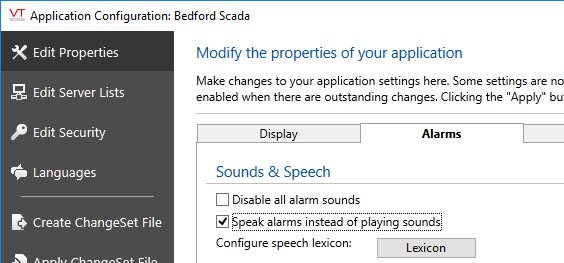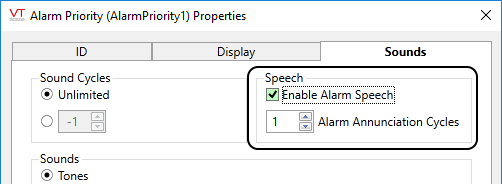Spoken Alarms on the Server or Workstation
You can control what details are spoken by changing the template property. (Alarm Message Templates) You also have control over how words are pronounced by adjusting the lexicon. ( Speech Lexicon Configuration).
If an alarm is acknowledged while it is being spoken, the voice will stop immediately .
Requirements:
To hear a spoken alarm, all of the following must be in place:
- Microsoft SAPI engine installed on the computer. (Installed by default with Windows®)
- The workstation has speakers and audio ability.
Refer to your system configuration. Ensure that the speakers are turned on and that the volume is set to an audible level, both on the speakers and in the computer.
- Application Properties related to the alarm text-to-speech system are set.
At a minimum, set the application property AlarmSpeechEnable to 1.

The list of properties was scrolled to this entry. This is not the first property in the page.
- The Alarm Priority tags is configured to enable alarm speech.
As shown in the following image, the Enable Alarm Speech option is selected and the Alarm Annunciation Cycles set to a value greater than 0 in the Alarm Priority tag used by your alarm.

Option available only if AlarmSpeechEnable is 1, as per previous step.
- The alarm is not configured to use a sound (.wav) file.
If the Alarm tag has a .wav file configured, only that sound will be played.
If the Alarm Priority tag has a .wav file configured, then if the number of sound cycles is set greater than 0, the .wav file will play before the spoken alarm.
If Sound Cycles is set to either 0, or Unlimited (-1), then only the spoken alarm will sound.
If Sound Cycles is set to 1, the tone will play once before the alarm is spoken.
Additional Configuration Options
The following options are available to you to control how, when and where alarms are spoken.
- An alarm is spoken or not based on the configuration of its Alarm Priority tag.
The Enable Alarm Speech is selected and Alarm Annunciation Cycles set greater than zero.
- Alarm tones or .WAV files may be played zero or more times before an alarm is spoken.
.WAV files may be configured in the Alarm Priority tag, but not in the Alarm.
Alarms with a configured .WAV file will not be spoken.
- Spoken alarms may be configured to play one or more times.
- Spoken alarms may be deactivated globally with the configuration setting, AlarmSpeechEnable.
- If using the SAPI speech engine, you can select which voice (supported by the speech engine) to use.
- You can select whether alarms should be spoken on all workstations, or on only the alarm server.
Configuration Settings
The following is an overview of the configuration settings that control the spoken alarms.
Set to 1 to enable spoken alarms. Alarm speech is disabled by default.
Use workstation-specific copies of this property to enable speech on some stations and disable it on others.
Provides a template for spoken alarms to use. May be a combination of words and replaceable parameters.
If using the Microsoft speech engine, there are several voices that you could use. You can select which voice to use with this variable. In general, it is best to set this variable to a dash (-) to indicate "configured Windows voice".
Determines the format quality used for speech using the Microsoft speech engine. The number used for this variable will match an entry in a numbered list of formats. When set to -1, the quality native to the voice engine will be used. The default value of 6 balances audio quality against network transfer overhead.
May be used to provide an initialization string to the speech engine to control the voice. Please refer to the SAPI documentation for the details of this initialization string.
May be used to select an alternate speech engine.
Obsolete. Maintained only for backward compatibility. If enabled, spoken alarms will not have access to the pronunciation configuration options.
